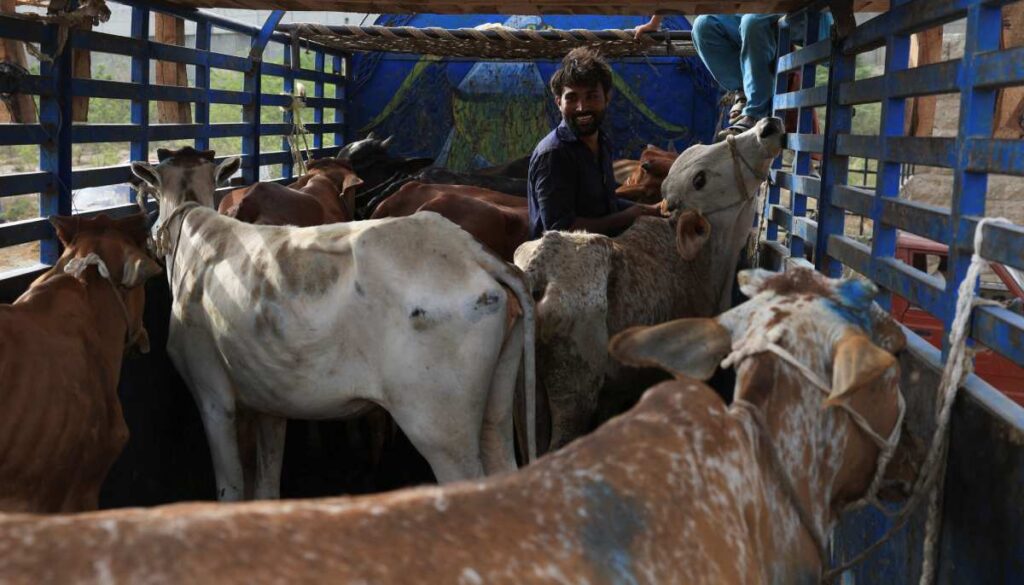If you haven’t had a cow block your car or a goat stare into your soul in the past week, are you truly experiencing Eid in the right place? Yes, it’s that special time of year again when our Instagram feeds transform into a full-blown livestock fashion show, and every street corner features sacrificial animals – be it goats, cows, sheep, or camels.
While Eid al-Fitr revolves around bangles, mehndi, and the sugar rush from sheer khurma, Eid al-Adha is predominantly about meat – from selecting and purchasing a sacrificial animal to the processes of cooking, storing, and sharing the meat. Everything else takes a backseat. The real festivities kick off weeks in advance with familiar questions like “Bakra liya? [Did you buy a goat?]”, “gaye ya bakra? [Cow or goat?]”, “kitne mein liya? [How much did it cost you?]”—a crucial inquiry—and the common lament, “bakray kitne mehngay ho gaye hain? [How expensive the goats have become!]”
Shafiq, 27, unloads sacrificial bulls for sale from a truck at a cattle market, ahead of Eid al-Adha celebrations, in Karachi on May 30, 2025. — Reuters
But before the meaty drama unfolds, it’s time for the sacred pre-Eid ritual: extensive home cleaning. Suddenly, those cobwebs on the fans, previously ignored, become a domestic emergency. For this Eid, in particular, a thorough cleansing of the refrigerator is essential. Preparing your refrigerator to store the meat is a revered chore; after all, it must be worthy of stocking half the neighborhood’s meat.
While some are quick to choose an animal for sacrifice, eager to keep it close and nurture it before Eid, for others, the quest for a perfect animal drags on until the very last minute—because why pick early when you can bargain, panic, and buy under pressure? Men diligently browse the mandis [cattle markets] day and night, transforming livestock shopping into a full-blown adventure sport.
You’ll also notice mini maweshi markets appearing at every corner, as some beoparis [traders] literally roam the streets with their animals, hoping to catch a buyer on the go. That’s the authentic charm of Bakra Eid: it’s not just the official mandis; everywhere you turn, you’ll find individuals quoting animal prices, while others bargain like seasoned pros, turning sidewalks into lively negotiation hubs.
A view of sacrificial animals for sale at a cattle market, ahead of Eid al-Adha celebrations, in Karachi on May 30, 2025. — Reuters
Meanwhile, the children are in their element—parading their animals like show ponies, forming impromptu street gangs, and passionately boasting about whose sacrificial animal is bigger, taller, more beautiful, or more expensive.
“Yeh chaar daant wala hai [This one has four teeth.]”, “yeh Australian hai [This one’s Australian.]”
The obsession men have with the sacred do-daant wala bakra [two-toothed goat]—the mighty donda [strong two-toother]—is undeniable. From kids to adults, everyone is busy decking out their animals with all sorts of glow-up accessories, as if prepping a celebrity for “Cow-ture Week.”
If something is in high demand and doesn’t become expensive in Pakistan—well, that would be a miracle. As Eid approaches, even tomatoes suddenly recall their worth and start demanding high prices. That’s why people now stock up and freeze them days before Eid al-Adha as if they were some kind of black-market currency.
On chhoti Eid [Eid al-Fitr], the only stress involves dealing with the tailor. But on Bari Eid [Eid al-Adha], you get the dual privilege of handling tantrums from both the darzis [tailors] and the qasais [butchers]. Even if, by some miracle, you manage to book one, there’s no guarantee he will show up on time.
Being satisfied with a butcher on Bakra Eid is almost impossible—someone in the house is always bound to be unhappy: “Isne gosht theek se nahi banaya. [He didn’t cut the meat properly.]”
Just as the rainy season brings out the barsaati mendak [seasonal frogs], Bakra Eid unleashes an entire army of mousami qasais [seasonal butchers]. Suddenly, you’ll find amateurs wielding knives and offering their “expert” services. Every year, countless families end up sacrificing not just animals—but also their precious meat, thanks to these self-declared qasais. Let’s all take a moment to pray: may we be spared from these meat-murdering laymen this year. Ameen.
“What to wear on Eid?” is one of the most agonizing questions for women every year. But let’s be honest, does it even matter? Because no matter how stunning your Eid outfit is, you’ll end up spending an eternity in a sweltering kitchen, cooking kaleji [liver] and phephray [lungs] for breakfast—right after the Qurbani [sacrifice] is done. And just when you think you’re done, it’s time to whip up another meaty dish for lunch… and then again for dinner. As for the kind of glam boys get on Bakra Eid, it’s the classic combo of banyan and shalwar, because for one day many of them transform into part-time qasais.
Bakhtawar, 23, and Irtaza, 22, parade a sacrificial camel, decorated with celebratory garlands, near Badshahi Mosque in preparation for the Eid al-Adha holiday in Lahore on June 6, 2025. — Reuters
And let’s not forget the “breathtaking” stench that permeates our homes and streets—with waste scattered across the roads, adding to the festive “decor.”
Bakra Eid is also incomplete without the familiar screams of “Unki gaye bhaag gayi! [their cow has run away!]”—followed by the classic sight of a cow sprinting down the road, with half the neighborhood chasing after it.
Another classic Bakra Eid sight: the pop-up chara [fodder] shops everywhere you look. Almost every shopkeeper suddenly turns into a fodder-monger. It doesn’t matter if their usual business is selling phone covers; you’ll see them proudly sitting behind stalls of chara as if they’ve been in the trade for generations.
When it’s time for Qurbani, you’ll also spot different kids in action. The emotional ones—heartbroken at the thought of their beloved animal being sacrificed. The thrill-seekers, hanging from terraces and peeking through windows, watching the Qurbani like it’s a live-action movie. And finally, the conflicted ones—watching with wide eyes while also subtly terrified of all the blood and chaos.
Another VIP guest of Bakra Eid is the “plastic shopping bag” (officially banned in many places but never truly vanishing)—playing a crucial role during the festivities. Once the meat is collected, the real mission begins—sorting mutton and beef into separate packets: some for freezing (to last an eternity), and some for distribution. Every year, there’s a solemn vow not to mix up the beef and mutton—and yet, a few days later, like clockwork, no one remembers which packet was which.
The most disheartening thing about Bakra Eid is that not only do you not receive any Eidi, but to top it off, your mom decides that every meal for the entire week must strictly revolve around meat. Morning, noon, and night—it’s just gosht, gosht, and more gosht. A culinary hostage situation!
A photograph of meat being barbecued at the occasion of Eid al-Adha. — APP
We practically honor every piece of the sacrificial animal. From siri to paye, we don’t even spare the tongue or the brain. And of course, how can we forget the glorious ojhri [intestine]—”delicious” to some, “bleh” to others?
Then comes the barbecue phase, celebrated with full zeal in almost every city of Pakistan a few days after Eid. It’s practically a national festival at this point. Thanks to the excessive dedication to “overeating meat,” a visit to the hospital often becomes part of the Eid tradition too.
Well, perhaps not entirely—but this festival has definitely changed a little. For instance, in some housing societies, certain meat businesses now offer Qurbani services where you pay a fixed amount, and in return, they perform the sacrifice and hand you over the meat. Some even deliver it to your doorstep. This practice is becoming increasingly popular in elite or upscale areas.
Unlike other festivities, including Eid al-Fitr, which have gradually digitized and arguably lost some of their soul over time, Bakra Eid somehow still embodies the warmth, traditions, and delightful chaos we grew up with. In times like these, we should truly cherish what we have—because in the end, it’s the memories that stay with us. These choti choti khushiyan [little joys] are more important than ever in this fast-paced, exhausting world. Hold on to them—they mean more than we realize.



